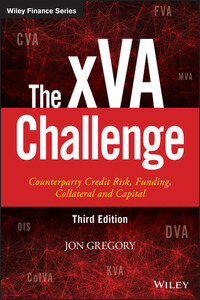For other titles in the Wiley Finance Series
The xVA Challenge
Counterparty Credit Risk, Funding, Collateral and Capital
Third Edition
Jon Gregory
This edition first published 2015
© 2015 John Wiley & Sons, Ltd
First edition published 2009, second edition published 2012 by John Wiley & Sons, Ltd
Registered office
John Wiley & Sons Ltd, The Atrium, Southern Gate, Chichester, West Sussex PO19 8SQ, United Kingdom
For details of our global editorial offices, for customer services and for information about how to apply for permission to reuse the copyright material in this book please see our website at www.wiley.com.
All rights reserved. No part of this publication may be reproduced, stored in a retrieval system, or transmitted, in any form or by any means, electronic, mechanical, photocopying, recording or otherwise, except as permitted by the UK Copyright, Designs and Patents Act 1988, without the prior permission of the publisher.
Wiley publishes in a variety of print and electronic formats and by print-on-demand. Some material included with standard print versions of this book may not be included in e-books or in print-on-demand. If this book refers to media such as a CD or DVD that is not included in the version you purchased, you may download this material at http://booksupport.wiley.com. For more information about Wiley products, visit www.wiley.com.
Designations used by companies to distinguish their products are often claimed as trademarks. All brand names and product names used in this book are trade names, service marks, trademarks or registered trademarks of their respective owners. The publisher is not associated with any product or vendor mentioned in this book.
Limit of Liability/Disclaimer of Warranty: While the publisher and author have used their best efforts in preparing this book, they make no representations or warranties with respect to the accuracy or completeness of the contents of this book and specifically disclaim any implied warranties of merchantability or fitness for a particular purpose. It is sold on the understanding that the publisher is not engaged in rendering professional services and neither the publisher nor the author shall be liable for damages arising herefrom. If professional advice or other expert assistance is required, the services of a competent professional should be sought.
Library of Congress Cataloging-in-Publication Data is available
A catalogue record for this book is available from the British Library.
ISBN 978-1-119-10941-9 (hbk) ISBN 978-1-119-10943-3 (ebk)
ISBN 978-1-119-10942-6 (ebk) ISBN 978-1-119-10944-0 (ebk)
Cover design: Wiley
Cover image: © Julia Kopacheva/shutterstock
Set in 10/12pt Times by Sparks – www.sparkspublishing.com
To Sylvia, Mimsie, Stella, Cara, Eliza-Joy, Stevie, Peach, Jim, Ginnie, George and Christy
One of the key features of the first and second editions of this book was the accompanying spreadsheets that were prepared to allow the reader to gain some simple insight into some of the quantitative aspects discussed. Many of these examples have been used for training courses and have therefore evolved to be quite intuitive and user-friendly.
The spreadsheets can be downloaded freely from Jon Gregory's website, www.cvacentral.com, under the counterparty risk section. New examples may be added over time.
The following is a list of Appendices that contain additional mathematical detail. TheseAppendices can be downloaded freely from www.cvacentral.com.
The first edition of this book focused on counterparty credit risk and was written in 2009, during the aftermath of the global financial crisis. Since then, the subject matter has necessarily broadened to give more attention to aspects such as funding, collateral and capital. It has been less than three years since the second edition was finished and again, the subject has changed dramatically. Indeed, as before, this is much more than a new edition because most of the content has been rewritten and expanded with several new chapters. I hope this will be a comprehensive reference for the subject we now generally refer to as xVA.
As with the last edition, I have saved space by putting mathematical appendices together with the accompanying spreadsheets on my personal website at www.cvacentral. com. Since many do not study this material in depth, this has proved to be a reasonable compromise for most readers.
I have also made use of a number of survey results and I am grateful to Solum Financial and Deloitte for allowing me to reproduce these results. I am also grateful to IBM and Markit who have provided calculation examples. These will all be mentioned in the text.
Finally, I would like to thank the following people for feedback on this and earlier editions of the book: Manuel Ballester, Ronnie Barnes, Raymond Cheng, Vladimir Cheremisin, Michael Clayton, Daniel Dickler, Wei-Ming Feng, Julia Fernald, Piero Foscari, Teddy Fredaigues, Dimitrios Giannoulis, Arthur Guerin, Kale Kakhiani, Henry Kwon, David Mengle, Ivan Pomarico, Hans-Werner Pfaff, Erik van Raaij, Guilherme Sanches, Neil Schofield, Florent Serre, Masum Shaikh, Ana Sousa, Richard Stratford, Carlos Sterling, Hidetoshi Tanimura, Todd Tauzer, Nick Vause, Frederic Vrins and Valter Yoshida.








